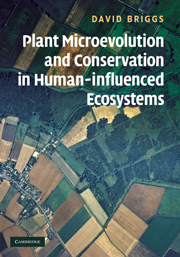Book contents
- Frontmatter
- Contents
- Preface
- Acknowledgements
- List of abbreviations
- 1 Introduction
- 2 Studying change
- 3 Key concepts in plant evolution
- 4 The origin and extent of human-influenced ecosystems
- 5 Consequences of human influences on the biosphere
- 6 Categories
- 7 Investigating microevolution in plants in anthropogenic ecosystems
- 8 Plant microevolution in managed grassland ecosystems
- 9 Harvesting crops: arable and forestry
- 10 Pollution and microevolutionary change
- 11 Introduced plants
- 12 Endangered species: investigating the extinction process at the population level
- 13 Hybridisation and speciation in anthropogenically influenced ecosystems
- 14 Ex situ conservation
- 15 In situ conservation: within and outside reserves
- 16 Creative conservation through restoration and reintroduction
- 17 Reserves in the landscape
- 18 Climate change
- 19 Microevolution and climate change
- 20 The implications of climate change for the theory and practice of conservation
- 21 Overview
- References
- Index
8 - Plant microevolution in managed grassland ecosystems
Published online by Cambridge University Press: 05 June 2012
- Frontmatter
- Contents
- Preface
- Acknowledgements
- List of abbreviations
- 1 Introduction
- 2 Studying change
- 3 Key concepts in plant evolution
- 4 The origin and extent of human-influenced ecosystems
- 5 Consequences of human influences on the biosphere
- 6 Categories
- 7 Investigating microevolution in plants in anthropogenic ecosystems
- 8 Plant microevolution in managed grassland ecosystems
- 9 Harvesting crops: arable and forestry
- 10 Pollution and microevolutionary change
- 11 Introduced plants
- 12 Endangered species: investigating the extinction process at the population level
- 13 Hybridisation and speciation in anthropogenically influenced ecosystems
- 14 Ex situ conservation
- 15 In situ conservation: within and outside reserves
- 16 Creative conservation through restoration and reintroduction
- 17 Reserves in the landscape
- 18 Climate change
- 19 Microevolution and climate change
- 20 The implications of climate change for the theory and practice of conservation
- 21 Overview
- References
- Index
Summary
Herbivory in anthropogenic ecosystems
Microevolutionary insights have come from investigations of a number of different kinds of managed grassland (hay, pasture, lawns and sports turf), and also from arable lands and managed forests. While, at first sight, management regimes are very different, they all involve selective herbivory.
Managed grasslands, rangelands etc.
In such habitats, humans take a harvest directly from the sward, either through haymaking or fodder collection, or, indirectly, through the management of domestic, semi-wild and wild animals. From the plant's eye view, harvesting by cutting and grazing are quite different. Harper (1977) makes this point very clearly, when he notes that, in clipping or mowing, some portion of the sward is more or less evenly removed. In contrast, grazing is patchy, and animals differ in their behaviour. ‘The cow rolls her tongue round a bunch of grass and pulls…sheep bite leaves between the incisors of the lower jaw and a pad on the upper jaw whereas the rabbit cuts leaves with teeth on both jaws.’ In addition, Harper makes it plain that the un-eaten portion of the sward is impacted by grazing animals, in their deposition of urine and dung and their tramping of the vegetation. Thus, ‘grazing animals frequently sit, lie, scratch and paw on pasture in addition to walking, running and jumping on it’ (Harper, 1977, 449).
- Type
- Chapter
- Information
- Publisher: Cambridge University PressPrint publication year: 2009



